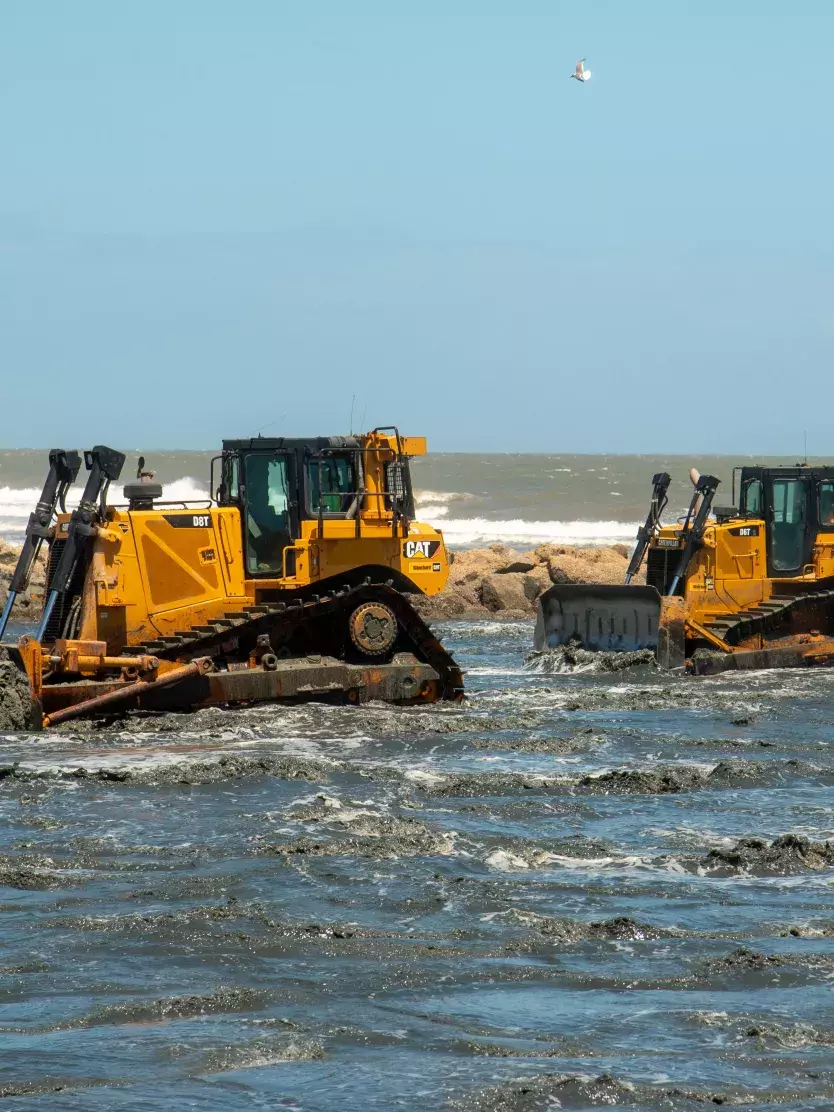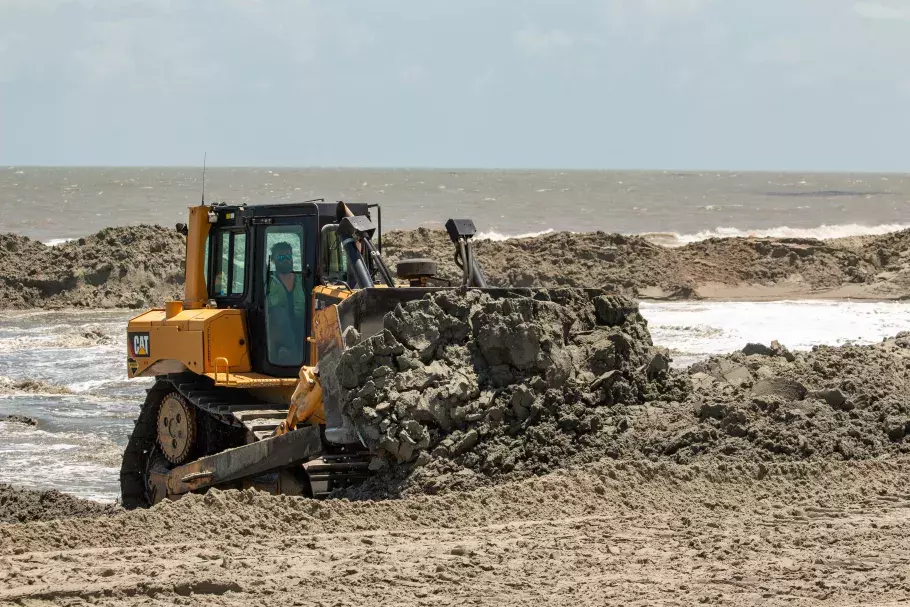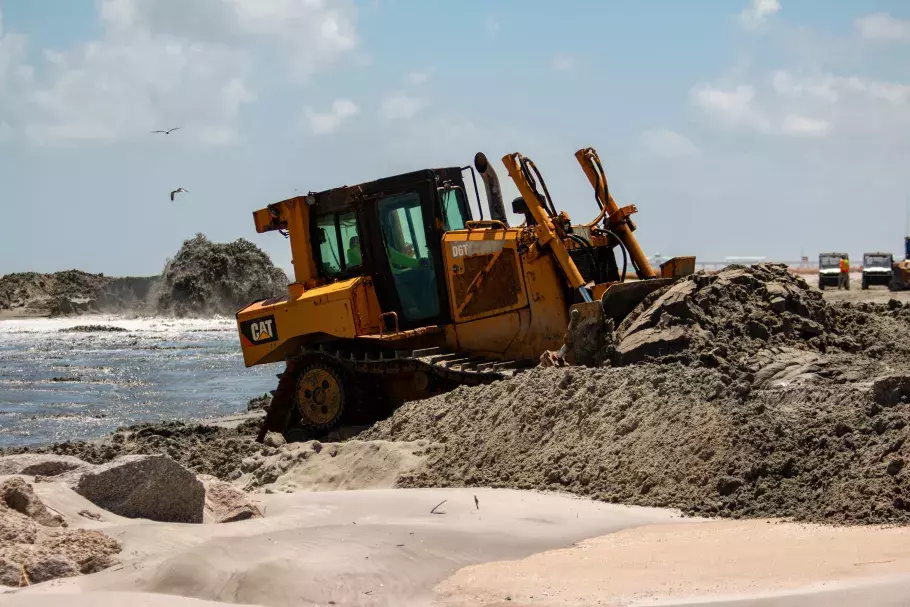
2025 Myrtle Beach
Beach Renourishment Project
Protecting Our Coastline – And Your Beach Experience
The Myrtle Beach area is undergoing a federally funded beach renourishment project to help protect life, property, and wildlife along our 60 miles of coastline. While this important work will be underway for several months, we want to assure visitors that most of the beach will remain open, and disruptions will be brief and minimal.
Beach renourishment restores eroded shorelines by placing sand back on the beach — strengthening our dunes, preserving habitats, and reducing the risk of storm damage. The project is led by the U.S. Army Corps of Engineers Charleston District, in partnership with local communities including North Myrtle Beach, Myrtle Beach, and Surfside/Garden City.

Why Is This Happening?
Severe erosion caused by Hurricanes Ian (2022) and Debby (2024) prompted a post-storm damage assessment, which concluded that beach renourishment was needed to maintain the coastline's integrity and protect the Grand Strand’s infrastructure, homes, and businesses.
This project places 2 million cubic yards of sand (equal to 200,000 dump trucks!) across 26 miles of shoreline.
A beach renourishment is necessary every seven to 10 years, depending on weather conditions and storms passing through the area. Horry County’s last beach renourishment was in 2019.
Will This Impact My Beach Vacation?
Very little. The project is carefully designed to keep most of the beach open and accessible.
- Work takes place in 1,000-foot sections at a time (about 3 city blocks).
- Each section is closed for only 2–3 days while crews work around the clock, 24 hours a day, 7 days a week.
- Visitors can still enjoy the rest of the beach — it’s easy to walk around the temporary work zones. Pipelines running along the beach outside of the fenced area can safely be crossed where the contractor places crossover sand ramps over the pipes. The public should keep away from lines and only cross them at the sand crossovers.
- Safety barriers and signage will clearly mark closed areas.
Stay informed with the real-time project tracker here:
🔗 Beach Construction Tracker (USACE)

How Long Will It Take?
- Work is expected to begin in spring 2025 and take up to 18 months, depending on weather and equipment availability. Crews will operate 24 hours a day, 7 days a week to stay on schedule.
Is It Safe?
Yes. Safety is the top priority. Here’s what to expect:
- Heavy machinery like bulldozers and pipelines will be present in work zones.
- Please stay out of closed areas and cross only where designated.
- Noise may occur during construction, including backup alarms from equipment — required by law for safety.
- A firm is contracted to monitor vibrations from the construction equipment throughout the project.
What About Sea Turtles and Wildlife?
The project is being conducted with full respect for local wildlife:
- Daily environmental monitoring is in place for sea turtles and migratory shorebirds.
- If turtle nests are found in construction zones, they are relocated and protected.
- If a turtle is present, all work in that area stops immediately.
What’s the Cost and Who’s Paying?
- The project is 100% federally funded through emergency relief from the U.S. Army Corps of Engineers.
- Total cost: $72 million — an increase from past projects due to rising equipment costs and greater sand needs.
-

How Does This Help Myrtle Beach?
- Provides critical storm surge and erosion protection.
- Preserves valuable habitats for sea turtles, shorebirds, and marine life.
- Supports our local economy — the Grand Strand sees 17.6 million visitors annually, generating $12.5 billion.
- Helps ensure that Myrtle Beach remains beautiful, safe, and resilient for future generations.
How does the sand get to the beach?
The sand is dredged from the offshore borrow areas into a hopper dredge. The hopper dredge motors from the borrow area closer to the project site and hooks up to a submerged pipeline. The submerged pipeline runs from just off the beach up onto the beach and connects to shore pipeline, which runs laterally along the dry beach. The sand is discharged as a water/sand slurry mixture through the pipeline, and bulldozers reshape the sand to meet the designed construction template.
The nourishment sand will be excavated by a hydraulic dredge and picks up small amounts of shell and mud with the sand. For that reason, newly placed sand at first often appears quite dark. Within a few days, however, the sun oxidizes the non-sandy material, and the beach eventually turns as light as it was before the project.
How Can I Stay Updated?
- The public can track the progress of the project on a real-time basis, including where the temporary closure will take place, with an interactive map created by the U.S. Army Corps of Engineers.
- Track progress daily: Construction Tracker
- Follow the U.S. Army Corps of Engineers Charleston District on:
- Facebook: @CharlestonCorps
- Instagram: @CharlestonCorps
- X (formerly Twitter): @CharlestonCorps
For more info, visit the official renourishment page or contact the Corps directly: 📧 [email protected] | 📞 (843) 360-3879
Thank You
We know how important your beach vacation is — and this project is about keeping our beaches beautiful, safe, and strong for many seasons to come. Thanks for your patience and cooperation as we complete this important work!

